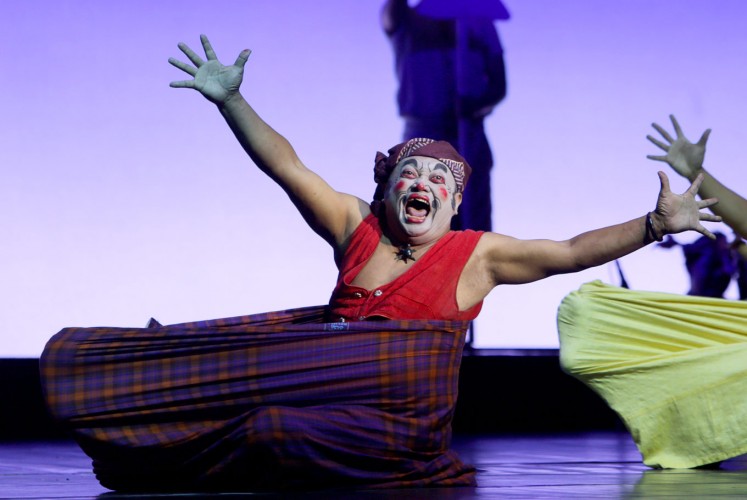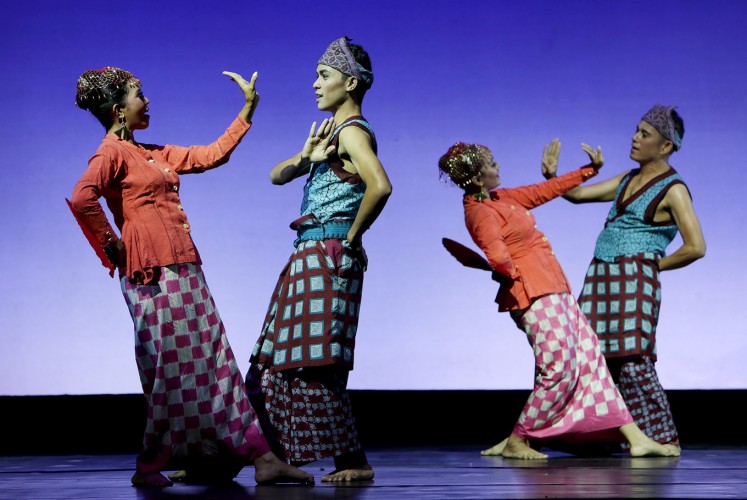Popular Reads
Top Results
Can't find what you're looking for?
View all search resultsPopular Reads
Top Results
Can't find what you're looking for?
View all search resultsI La Galigo an epic performance of visual and aural mastery
The I La Galigo Revival 2018 is one of those once-in-a-lifetime theatrical performances that come around and leave those lucky enough to watch them breathless in wonder.
Change text size
Gift Premium Articles
to Anyone
W
hen the performance on Friday night ended, the audience all stood up for a thunderous standing ovation that lasted for at least ten minutes as the musicians and performers lined the stage and took their well-deserved credit.
“It was so gorgeous that I am at a loss for words,” one of the spectators, Ruth Onduko, said.
Other spectators shared her opinion, and this came as no surprise. Despite its lengthy duration of nearly three hours, the performance was mesmerizing in every aspect.
The idea behind the performance came from the Sureq Galigo mythological epic poem of the indigenous Bugis people living in South Sulawesi.
The poem, which is enshrined in the UNESCO’s Memory of the World and considered the most voluminous literary work in the world, has many similarities with the genesis stories of other civilizations.
The similarities range from the division of the universe into three realms, with mankind populating the middle world and the deities of the upper world sending their offspring to rule over mankind in the struggle of humans to find true love.
I La Galigo focuses on the struggle of Sawerigading, a young prince and a descendant of a deity, to find his true love.
His first love toward We Tenriabeng is impossible, since the lady is his twin sister and their union would spell doom for the kingdom.
His second love to Chinese princess We Cudaiq is marred with unresolved animosity.
Hilarious: Sawerigading’s two cousins are court jesters that offer the nearly three-hour long performance a few humorous moments. (JP/Wendra Ajistyatama)The fruit of their union, the eponymous La Galigo, grows into a spoiled rascal who wanders from island to island stealing other men’s wives.
The story ends when the supreme deity, Patotoqe, purges the middle world and declares the gods will no longer intervene in the affairs of men.
The mesmerizing quality of the performance can be attributed to the mastery of its creators.
Rhoda Gauer, who was responsible for the text adaptation and dramaturgy, has done a miraculous job of condensing the enormous text into a manageable and comprehensible twelve-scene performance.
Imagine the interpretational nightmare the director must undergo and the mental agony the spectators must suffer if the text — reported to be 6,000 pages or 300,000 lines of text — were to be performed in its entirety.
Robert Wilson, the director as well as the principal set and lighting designer, obviously made several difficult decisions that in the end turned the theatrical piece into a world-class act.
Take, for instance, his decision to leave the stage virtually empty of any props. The backdrop was a huge, unadorned screen that changes color in accordance to the mood of the scene. That bare stage provides the spectators with a distraction-free space, where their eyes could focus solely on what the performers were trying to convey.
Celebration: Commoners dance happily as Sawerigading tries to mend his broken heart by partying and enjoying cockfights. (JP/Wendra Ajistyatama)Wilson’s decision to craft a performance in which the actors speak no lines destroyed the language barrier that would otherwise present a challenge to both the performers and spectators. Lines in Bugis, Indonesian or English would surely diminish the universal appeal of the performance.
That decision also opened an opportunity for another element of the performance to soar. That element is music, and it indeed soared to a heavenly level.
Prominent Indonesian composer Rahayu Supanggah created a musical repertoire that integrates hauntingly beautiful musical compositions with the singing and chanting of certain parts of the epic poem.
The repertoire was so moving that a spectator could close their eyes and would still be able to understand what was going on just by listening to the music.
Yet, there were not many instances in the performance where spectators would want to close their eyes. The colors of the costumes, the dynamics of the dances, the battle sequence, the clever choreography — dancers locked their feet together to form a ship — and the stunning light arrangement compelled spectators to keep their eyes open throughout the performance.
It was the kind of performance that needs to be watched, because reading about it would simply be insufficient.
The contrast delivered by the opening scene, in which men and women slowly enter the stage with various objects in their hands to tunes of music, and the closing scene, in which they slowly enter the stage without carrying anything and without any musical accompaniment, is so symbolically poignant that it deserves its own review.
The price of love: Sawerigading chops down Welenrennge, the largest and most sacred tree, to build a fleet of ships that he would use to cross to China, where Princess We Cudaiq is. (JP/Wendra Ajistyatama)I La Galigo was first premiered in 2004 and toured scores of prestigious venues across the globe, including Singapore’s Esplanade and New York’s Lincoln Center Festival.
The original production received a remarkable reception and reviews from both theater-goers and critics.
In conjunction with the 2018 International Monetary Fund and World Bank Group Annual Meetings in Bali, the theatrical piece was performed for four nights on a specially constructed stage in Nusa Dua’s beachside Peninsula area.
I La Galigo was produced by the Bali Purnati Center for the Arts in partnership with Bumi Purnati Indonesia and EdM (Elisabetta di Mambro) Productions. The project was under the auspices of Yayasan La Galigo and Indonesia’s Creative Economy Agency (Bekraf).
Some major corporations threw their weight behind the production, including state-owned Bank Mandiri, which poured in around Rp 700 million (US$46,145) to finance the theatrical production.
“We support this production, because we want the participants of this international gathering to have the opportunity to witness the magnificent diversity of our cultural heritage,” Bank Mandiri corporate secretary Rohan Hafas said.














